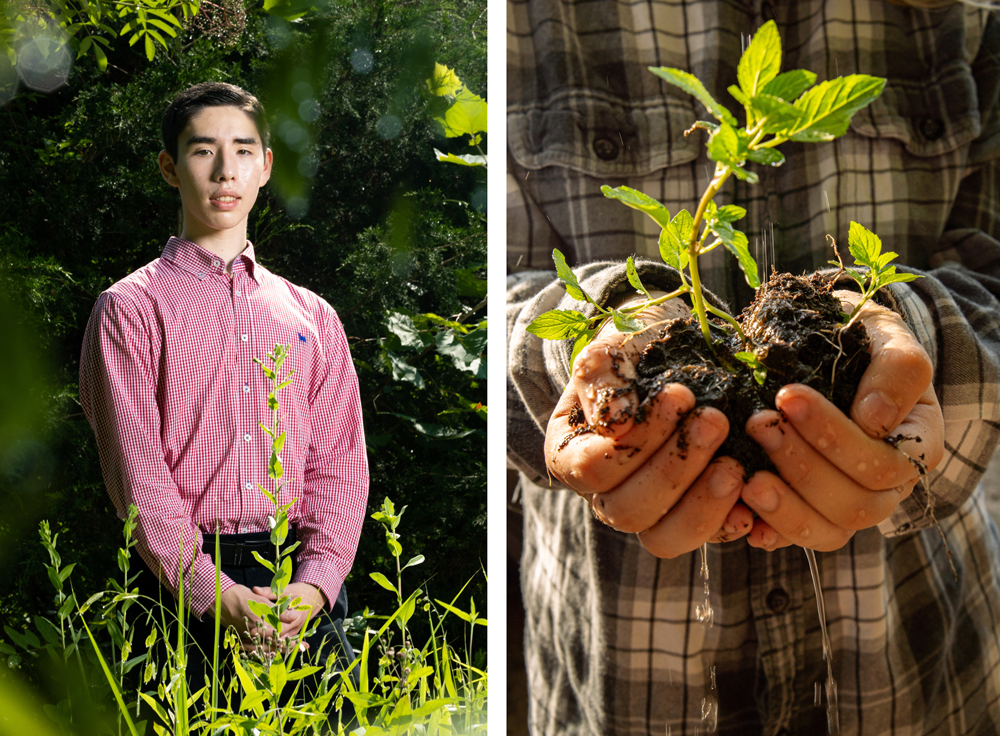Listen to the story:
The summer sun glistens on the leaves at Brumley Nature Preserve as rising junior Alexis Siegler weaves between the pines. Fallen twigs crunch beneath her feet as she drags a square white cloth the size of a small blanket behind her, her eyes fixated on the ground.
It is only the second day of her summer internship — and her first tick drag. After an hour of work, PhD student Peyton Pretsch spots a tick on Siegler’s cloth and eagerly alerts her of the news: She was the only one who collected a tick that day.
Siegler is one of 10 undergraduates who participated in the Carolina Population Center’s (CPC) Summer Undergraduate Intern Program. During the eight-week-long paid internship, students are exposed to fieldwork and statistical programming, participate in professional development workshops, and work directly with faculty and staff on research projects. At the end, they present their findings at a research symposium.
“There’s only so much you can do in eight weeks,” says Abigail Haydon, CPC’s training program manager. “But it’s enough time to get exposed to new things, add new skills to your toolbox, and get a sense internally if this is something that you want to do more.”
This year’s interns were immersed in a variety of projects, from measuring the short- and long-term impacts of storms in eastern North Carolina to studying the effects of racism on the brain and immune system.
Alexis Siegler

Left: Tweezers grasp a tick in the lab. Right: Alexis Siegler studies and tracks tickborne diseases locally. (photos by Caroline Bittenbender)
When Alexis Siegler becomes interested in something, she becomes obsessed.
She loves reading, for example, often procrastinating other duties to curl up with a copy of The New Yorker.
She is also captivated by the color yellow. Most Wednesdays and Fridays this past summer, she’d pack her yellow fanny pack full of essentials — yellow tape, labels, and vials of ethanol — and travel to the Occoneechee Speedway Trail in Hillsborough, where she’d assist her teammates in operating the SECVBD TickBot.
The TickBot is a remote-controlled vehicle invented by Holly Gaff and the Department of Biological Sciences at Old Dominion University. The robot lures ticks by releasing carbon dioxide as it drags a pillow-sized cloth treated with permethrin, a chemical that instantly kills the ticks on contact.
The goal is to test the TikBot as a tool to reduce and control tick populations in grassy vegetation areas so people can enjoy nature without worrying about getting bitten.
Carolina epidemiologist Ross Boyce and his lab have been tasked with testing and reporting findings with the TickBot across the Chapel Hill area to study and track tickborne diseases — and Siegler’s CPC summer internship allowed her to get in on the action.
“I feel like a lot of people in North Carolina aren’t aware of tickborne diseases and things they can do to prevent ticks, such as treating their clothes in permethrin, because they have previously been less common around here,” Siegler says. “So, that lack of preparation makes this research more relevant.”
When Siegler wasn’t out in the field running the TickBot, she was analyzing data from a study focused on developing PCR testing for ehrlichiosis — a bacterial infection spread by the lone star tick, endemic to the southeastern U.S. Most people diagnosed with ehrlichiosis can recover quickly with antibiotics, but if left untreated, it can be fatal.
Many of the current blood tests used to diagnose ehrlichiosis are unreliable, according to Siegler. Two tests are needed about two to four weeks apart, and most patients don’t return for the second one.
“When patients first present to clinicians, they often test negative for ehrlichiosis when in reality the patient just hasn’t developed detectable levels yet and they may have the disease,” Siegler says. “So that’s pretty problematic.”
Switching to PCR testing could be more efficient, more reliable, and more convenient for patients. It utilizes a molecular approach and can detect ehrlichia DNA in the blood to immediately confirm the infection. Only one test is needed.
To determine which patients would be eligible for a PCR test, Siegler screened records from 1,457 UNC Health patients tested for tickborne diseases, 945 of whom tested positive for ehrlichiosis. But only 12 cases were confirmed. Because of the uncertainty behind the results of the blood test, Siegler found it alarming that ehrlichiosis may be going undetected and untreated in so many people.
“In epidemiology, you’re able to find gaps in understanding and then utilize studies and design different models to fill them,” Siegler reflects. “And I think that that was really meaningful to me.”
Samuel Kornylak

Left: Samuel Kornylak studies the effects of saltwater intrusion on agricultural communities. Right: Wet hands hold a plant. (photos by Caroline Bittenbender)
“I’ve always been a huge geography nerd,” junior Samuel Kornylak declares with a grin. “I like reading maps from different places and different times in my spare time. And I’ve always just been interested in how geographic phenomena affect the economies and the social characteristics of different places, especially places near where I live in North Carolina.”
This summer, Kornylak combined his passions for economics and the environment by working with Carolina geographer Conghe Song on a research project focused on salinity intrusion — when groundwater in a coastal region is replaced with saltwater due to rising sea levels and climate change, or overuse of existing groundwater. As sea levels rise and storms increase in intensity, storm surges and high tides cause ocean water to infiltrate groundwater aquifers.
Coastlines are often the frontlines of climate impacts. Approximately 40% of the world’s population lives within 60 miles of the coast — that’s more than the population of the United States, India, and China combined. Saltwater intrusion into the groundwater supply has serious implications for global food security, threatening crop yields and drinking water sources.
The agricultural communities of eastern North Carolina are no exception to these threats. More than 2 million acres of the state’s farmland sit along the coastline, and their low elevation puts them at high risk of flooding from heavy rains and hurricanes.
This summer, Kornylak conducted a literature review on previous findings about the effects of salinity intrusion on agricultural communities, as well as the extent of saltwater intrusion in the state. He found that global research from every continent except Antarctica struggles to address the same problem: the disproportionate effects of salinity intrusion.
“I think it surprised me how geographically diverse salinity intrusion is,” Kornylak says. “If it affects disproportionate groups of people in Vietnam and Bangladesh, then that’s likely also the case in North Carolina.”
Kornylak also analyzed agricultural census data to assess changes over time in Black and white farm ownership in coastal N.C. Understanding who is impacted could lead to state and government programs that support farmers financially, reduce carbon emissions, and build local storm surge gates for communities that need more protection.
“In North Carolina, specifically, agriculture is very important,” Kornylak says. “Saltwater intrusion could be a real threat to the economy of these counties and to the high percentage of the rural population who are either directly or indirectly employed in agriculture or agricultural industries.”
The CPC summer internship program is Kornylak’s first formal exposure to research, allowing him to contribute methods learned in the classroom to scientific discovery in the real world.
“I’ve learned how to do things that you can’t do as a class assignment, like a big literature review or planning a longer-term project and sort of envisioning what something is going to look like five years from now when you’re just starting it.”
Stephanie Forlemu

Left: A hand holds a fake brain. Right: Stephanie Forlemu studies the effects of anti-Black racism on the brain and immune system. (photos by Caroline Bittenbender)
Senior Stephanie Forlemu’s father is from Cameroon, a country in West-central Africa that shares boundaries with Nigeria to the north and Equatorial Guinea to the south. As a second-generation immigrant, Forlemu has found that the intersection of her cultural, racial, and ethnic identities makes her social and physical experiences inherently unique.
Her interests in neuroscience and in navigating her personal identities are what motivated her to apply for a CPC summer research project investigating the effects of anti-Black racism on the brain and immune system.
Forlemu worked in the Carolina Social Neuroscience and Health (SNH) Lab under the leadership of Keely Muscatell. A UNC-Chapel Hill psychology and neuroscience professor, Muscatell oversees an ongoing study uncovering how social stress can directly impact inflammation, leading to mental health conditions and chronic disease.
Forlemu quickly became fascinated by the links between ethnic identity, depression, and physical health in Black populations.
For the project, she led three-hour-long sessions where participants were given an allergen before completing an array of social and cognitive tasks. She collected data on their psychological and physiological responses before and after each task.
The goal? To understand how and why different people cope with stress related to discrimination.
During the post-session debriefing interviews, many of the participants reminded Forlemu of her own experiences as a second-generation immigrant.
“I heard a lot of people say that the way they cope with things is very different because they are not from here, or their parents aren’t from here,” Forlemu says. “It was a cool moment for me to see that I wasn’t alone in feeling those tensions.”
One goal of the SNH Lab is to shed light on how interpersonal discrimination contributes to higher levels of chronic disease in Black Americans, who are more likely to be exposed to stressful life events like discrimination, food insecurity, and socioeconomic deprivation than their white counterparts.
But rates of diagnosed depression in Black Americans are lower than in white Americans.
“It doesn’t make sense when you think about it,” Forlemu says. “Because if Black people experience more stress because they’re deemed to be a marginalized population, you would think it would increase risk for outcomes like depression.”
Studies show that Black Americans’ lack of access to mental health resources leads to fewer diagnoses.
This phenomenon is called the Black-White Depression Paradox.
Forlemu hopes that by continuing research on this disparity in graduate school, she can learn how ethnic identity and other psychosocial factors can influence neuroimmune interactions and protect against depressive symptoms in Black populations.
“Just be kind to people,” Forlemu urges, “because that has a really big effect on the stress that people go through in their lives and their physical health.”
Amelia Maani

Left: A slow exposure captures cars at night on a busy highway. Right: Amelia Maani studies migration in North Carolina. (photos by Caroline Bittenbender)
When she was 12 years old, Amelia Maani packed her bags, said goodbye to her friends, and prepared herself for the journey of a lifetime. Her family moved over 7,000 miles from Arizona to China, where they lived for four years before coming to Chapel Hill.
Maani knows the nerves, the excitement, and the shock of leaving behind the familiarity of home. This past summer, she applied her first-hand experience to research on migration and the demographic history of North Carolina as a CPC summer intern.
The Carolina junior interned under the leadership of sociology professor and CPC Fellow Barbara Entwisle. Entwisle’s current projects utilize electronic health records to study population health and examine links between the migration process and culture. Maani’s research will contribute to proving the historical significance of migration and mobility in the state.
When conducting a literature review, Maani was shocked to find that there is little information to be found on migration patterns in North Carolina.
“A lack of information is also information,” Maani states. “It shows that this is not something people are thinking about, that there is a gap in knowledge.”
Maani was challenged to take a traditional approach to research. She found herself in libraries flipping through public records and analyzing dissertations dating back to the 1940s.
“I think learning that practice of skimming and searching for salient information was important,” Maani reflects. “There’s no command+F function, so it required more work.”
Maani believes that one component makes North Carolina especially unique compared to other states when it comes to attracting migrants: the Research Triangle Park. Universities and tech industries in the region create a pull factor, providing opportunities for higher education and higher income that persuade people to migrate to the state.
Unlike New York or California where the ebb and flow of migration has been consistent throughout recent history, North Carolina has become a “hub state.”
“North Carolina is like this emerging gateway for immigrants,” Maani says. “It’s a new center where we will be seeing a lot of demographic shifts, whereas maybe other states have already seen that demographic shift.”
Maani also noticed significant changes in the state’s demographics within only the past 30 years. By the late 1980s, most immigrant residents in North Carolina were from Germany and West Germany. In the 2010s and 2020s, the top countries of origin for foreign-born residents rapidly changed to Mexico and India.
This shift in demographics paints a picture of how quickly immigrant communities from around the world choose to migrate to North Carolina, and how immigrant communities impact the cultural and economic life of the state.
Maani hopes her research can give insight into the micro-analysis of smaller movements. Analyzing migration of residents across county lines and the motivating factors behind these movements — including race, ethnicity, economic status, and birth cohort — can allow for a better understanding of the social and economic forces driving regions within the state.
“Often when we think of migration, we think of international migration or large-scale movements of people,” Maani says. “That’s definitely important. But I think sometimes we don’t even think about small movements — and how that can impact a population in a county or a city.”
Sara Ahmed

Left: Sarah Ahmed studies the short- and long-term impacts of storms in North Carolina. Right: Sea oats blow in the wind on the dunes of the Outer Banks. (photos by Caroline Bittenbender)
Hurricanes are routine for junior Sara Ahmed.
First, she and her family clear the yard to make sure objects don’t become flying debris and damage their home. Next, she makes sure she has flashlights with working batteries, first-aid supplies, and plenty of food and water bottles. Finally, everyone must have an exit strategy and a place to seek shelter in case the storm worsens.
Growing up in Wilson, N.C., Ahmed witnessed the many impacts of hurricanes near the coast.
So, when applying to work at the CPC this past summer, she was immediately drawn to the Dynamics of Extreme Events, People, and Places (DEEPP) project, to which she could apply her biostatistics major and her first-hand experience with hurricanes to assess the short- and long-term impacts of storms in North Carolina.
The DEEPP project is managed by sociologist Elizabeth Frankenberg. By combining household survey data with high-resolution satellite imagery, the research team at DEEPP works to inform communities and policymakers on how to better prepare for and recover from natural disasters.
Interviewers from CPC travel to the coast and conduct household surveys on Ocracoke Island and in Craven, Carteret, Dare, and Hyde counties. Ahmed experienced the research process at nearly every stage, including formulating survey questions, combing through and categorizing responses, manually entering the data, and processing and interpreting results.
“It was interesting because I was able to see how people responded and the results of the data,” Ahmed says. “Then you can see how certain actions taken actually help for disasters in the future.”
Ahmed worked to improve the study’s youth questionnaire for 15- to 17-year-olds by writing new questions: Do you think the level of flooding has increased throughout hurricanes in your lifetime? Do you think you will want to live here in the future? How do you think living in this area will be affected by tourism?
Responses to questions like these are critical in understanding place attachment for youth on the coast.
As a biostatistics major, the most exciting component of the internship for Ahmed was analyzing the data to assess how populations behave socially and economically in response to hurricanes.
“Another thing I looked at was how people react after hurricanes,” Ahmed says. “Did they take action to prevent damage from future hurricanes? A lot of people started to elevate their homes and upgrade their mechanical and HVAC systems.”
Ahmed combed through data responses from residents who experienced the effects of Hurricane Florence in 2018 and Hurricane Dorian in 2019. She noticed a significant geographical difference that makes N.C. stand out when responding to hurricanes.
“North Carolina is unique because of the Outer Banks,” Ahmed remarks. “The hurricanes definitely affect them in a different way than they do the mainland.”
While residents on the mainland were displaced by Hurricane Dorian for only a few weeks, those on Ocracoke were displaced for months on end, some even up to a year or more. But when survey respondents were asked if they were displaced after Hurricane Dorian, residents on mainland North Carolina answered as if they were still displaced from Hurricane Florence.
“That was just sort of mind-blowing to me because it had already been more than a year, and these people are still feeling the impacts of that,” Ahmed says.
The only ways to evacuate Ocracoke Island in the event of a hurricane are by state ferry or private boat or plane. When the ferry is closed for long periods of time, many residents choose not to leave.
Ahmed also learned that residents may choose to stay so they can combat the effects of extreme flooding immediately following a storm.
“If they are not able to come back for weeks at a time, the flooding can cause your house to be moldy, and they want to be there to take action right away,” Ahmed says.
Hurricanes are nothing new for coastal communities, but the risk of damage and displacement from extreme flooding continues to grow. DEEPP asked community members how they think the coast will change in the next 15 years, and Ahmed feels the results are cause for concern.
“People responded to that question saying the Ocracoke might not be here anymore because the water levels will rise,” Ahmed says. “I feel like things like that need more attention. It’s really important to have this information so that people in the communities and policymakers know what to do to prepare for these disasters and how to recover.”
Ahmed hopes to use the skills she gained during her CPC summer internship to continue researching population sciences and to one day work at the CDC.
“I enjoyed being able to work in different areas and to get a better understanding and appreciation of all the things that go into a big study like this.”


